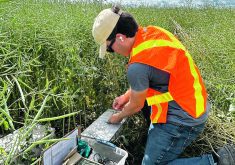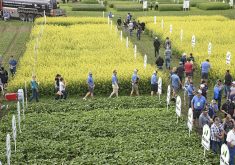This special report marks the start of our three-part series on the Comprehensive Economic and Trade Agreement between Canada and the European Union. A team of writers from Glacier FarmMedia, which includes The Western Producer, spent four months tracking developments and interviewing experts on all sides of the debate to assess the value of CETA to Canada’s agricultural community. Parts two and three will run over the next two weeks. The agreement will likely come into effect in 2017, but still requires ratification from all 28 EU members, the European Parliament and Canada. Stories from Parts 1 and 2 are linked below. Understanding the preferences of consumers in Taiwan and how they differ from Indonesia or Malaysia isn’t easy for a small company in Saskatchewan.
Read Also

New program aims to support plant-based exports to Asia
The man on the other end of the phone is confused.
“I have not heard of this before,” Marek Nowak says slowly.
“I am of no help for this.”
He’s been asked about how the Comprehensive Economic and Trade Agreement between Canada and the European Union might affect Polish dairy farmers such as himself. However, like most European dairy producers, he hasn’t heard anything about the yet-to-be ratified trade deal.
That doesn’t surprise Sylvain Charlebois, a professor at the University of Guelph’s Food Institute, who recently returned from a 10-month sabbatical in Europe.
Other stories in this Special Report:
- Will EU trade reap benefits for all?
- Niche growers hope CETA will resolve GM issues
- CETA not silver bullet for European trade
- Resolving the beefs blocking beef trade
- Doors may be open but welcome mat takes time
- ‘600 million opportunity’ awaits cattle sector
- Bison seen as biggest benefactor
He said the deal hasn’t made headlines across the Atlantic.
“It’s absolutely a non-story,” said Charlebois.
“I actually didn’t hear about it once.… I was speaking to dairy farmers, and they weren’t aware at all.”
However in Canada, it’s a different story.
Dairy Farmers of Manitoba chair David Wiens said every time a trade deal is signed here, it raises concerns.
“Because every time, there is a little bit more access given,” he said.
CETA will allow 18,500 tonnes of tariff-free cheese into Canada, including 16,000 tonnes of fine cheese, 1,700 tonnes of industrial cheese and 800 tonnes under existing tariff-rate quota.
And that doesn’t count the 13,471 tonnes of market access the EU already enjoys.
Dairy Farmers of Canada equate the CETA concessions to a 2.25 percent reduction in quota or a farm revenue loss of $150 million a year.
Miriam Sweetnam, whose family operates Sweetridge Farm near Winkler, Man., said it wasn’t the province’s weather that brought her family to Canada 15 years ago.
“The draw to Manitoba was the quota system here. Yes, it’s expensive to get into, but you can buy quota in increments,” she said.
“We are from Ireland, where the quota that you had on your farm was the milk produced on that land in 1983. So you couldn’t access any more quota to put up a barn, to pay for that barn, so you were tied.”
Sweetnam and her husband wanted their children to have choices as they got older.
“Our push has always been to be big enough to allow that second generation in, if that was the choice they made,” she said.
“We saw what happened in Ireland with the quotas being dissolved, and we didn’t want to be in that position again. We knew we had to be big enough to be strong enough to take any blips in the market, whether they be CETA or the Trans-Pacific Partnership.”
With that in mind, the Sweetnams expanded their operation and today farm 600 acres and milk 250 cows.
Sweetnam said she believes Canada’s supply managed system remains — if not entirely intact — at least secure, despite losing market access to the EU.
Anton Borst agreed the Canadian government isn’t looking to dismantle supply management, but he also isn’t pleased with the loss of market access.
“Any time the government gives market share, it makes you concerned about how much the government is behind supply management, and in that regard it might make you a little more careful about when you expand and how you invest in your operation,” said the fifth-generation dairy producer, who farms near Elm Creek, Man.
However, he said recent trade negotiations have shown the federal government’s commitment to a supply managed dairy industry.
“They’ve demonstrated that they are behind it, but also that it’s not totally, necessarily untouchable,” he said.
“In one way it’s reassuring, and in the other regard it is a bit of a concern.”
Charlebois said it’s a given that Canada’s next generation of dairy farmers will be operating in a different marketplace than their parents.
“As soon as you start allowing more products from abroad, it really creates an imbalance, and then you’re forced to revisit how you manage the entire regime,” he said.
“I mean, quota values will be affected, processing will be affected and how assets are evaluated will be affected.… It’s a start of a new transition period. I think the dairy sector … understands that the current model is no longer sustainable.”
It doesn’t mean the end of supply management, but it means producers and governments need to start planning for “supply management 2.0.”
Charlebois said the stumbling block is that government has not been entirely forthcoming with a long-term strategy for Canadian dairy as it moves toward ratifying new trade deals.
“We are signing these trade deals all over the world, but I think that someone has to start explaining to dairy farms that we not only need to think about the future for them, but we need to figure out how a new system could co-exist along with a strategy very heavily focused on trade,” he said.
Agri-Food Economic Systems Inc. founder Al Mussell said trade deals have to be viewed in the larger context. Not only are Canadian dairy producers losing market share, but they are also facing issues at home.
“The reason that I think this is really an important issue for the dairy industry is that there are plenty of other issues going on in dairy supply management, and you can’t take the EU cheese deal as distinct from those issues.
“Basically, the issue is that we’re awash in non-fat milk solids and cheese is an interesting product from the standpoint that it’s a mix of butterfat and non-fat solids. And anything that brings more non-fat solids in here creates problems for us on that basis alone.”
Combine that with cheese export caps and a World Trade Organization ruling that Canadian cheese is subsidized if exported below domestic prices, and Canada’s hurdles multiply.
“So the cheese that comes in here, we cannot offset by exporting,” Mussell said.
Not that demand for Canadian cheese is high in Europe, if it exists at all. Sweetnam said she hasn’t seen a big interest in Canadian cheese when she visits Europe.
“They are also very good at what they do, and they have a lot of artisan cheese makers,” she said.
“Other Canadian products, yes, but not much interest in cheese.”
Canadian consumers also tend to view European cheese as superior to Canadian product.
“The other factor is the quality — the quality of cheeses in Europe is world renowned — and that’s why I suspect Canadians won’t mind eating more European cheeses,” said Charlebois.
Dairy Farmers of Canada president Wally Smith said the organization has worked to promote Canadian cheese abroad, but it primarily focuses on the domestic market. Efforts to establish Canadian dairy products as the safest and most sustainable through the ProAction initiative and the Blue Cow logo will continue, he added.
He said market losses resulting from trade deals such as CETA must be compensated, and money such as the $4.3 billion promised by the previous federal government after the Trans Pacific Partnership was negotiated is crucial.
“(Quota is) my important asset that generates cash flow on my farm. It’s something that most of us have invested heavily in.… Now I’m left with less that 97 percent. I’ve given that up forever,” he said.
“As far as the revenue stream is concerned, in that package of dollars for the dairy farmers so there is no negative impact, there is also a potion of that money that’s applied to the CETA negotiation.”
However, no money will flow unless the federal government ratifies CETA and commits to its predecessor’s promise of compensation.
Manitoba’s Wiens said for now, dairy farmers will continue to move forward.
“We will do as we have done ever since the beginning of supply management — adapt.”
Economic snapshot
- The agreement is more than 1,600 pages long and is expected to increase trade in goods and services between the EU and Canada by nearly a quarter, by eliminating almost all import duties.
- It is expected to lift EU output by about C$18 billion a year.
- The EU market has 500 million people and annual economic activity of almost $18 trillion
- In 2014, Canada exported $3.32 billion worth of agri-food to the EU.
- Canada is the 12th most important food and beverage importer for the EU, and accounts for 2.2 percent of all EU agri-food imports.
- Canada is the 10th most important destination for EU agricultural exports.
- The EU is the second largest importer of food and beverages into Canada.
- In 2014, the EU exported $4.63 billion worth of agri-products to Canada. The main category includes wine, beer and spirits, which together account for more than 40 percent of total EU agri-food exports to Canada.

















